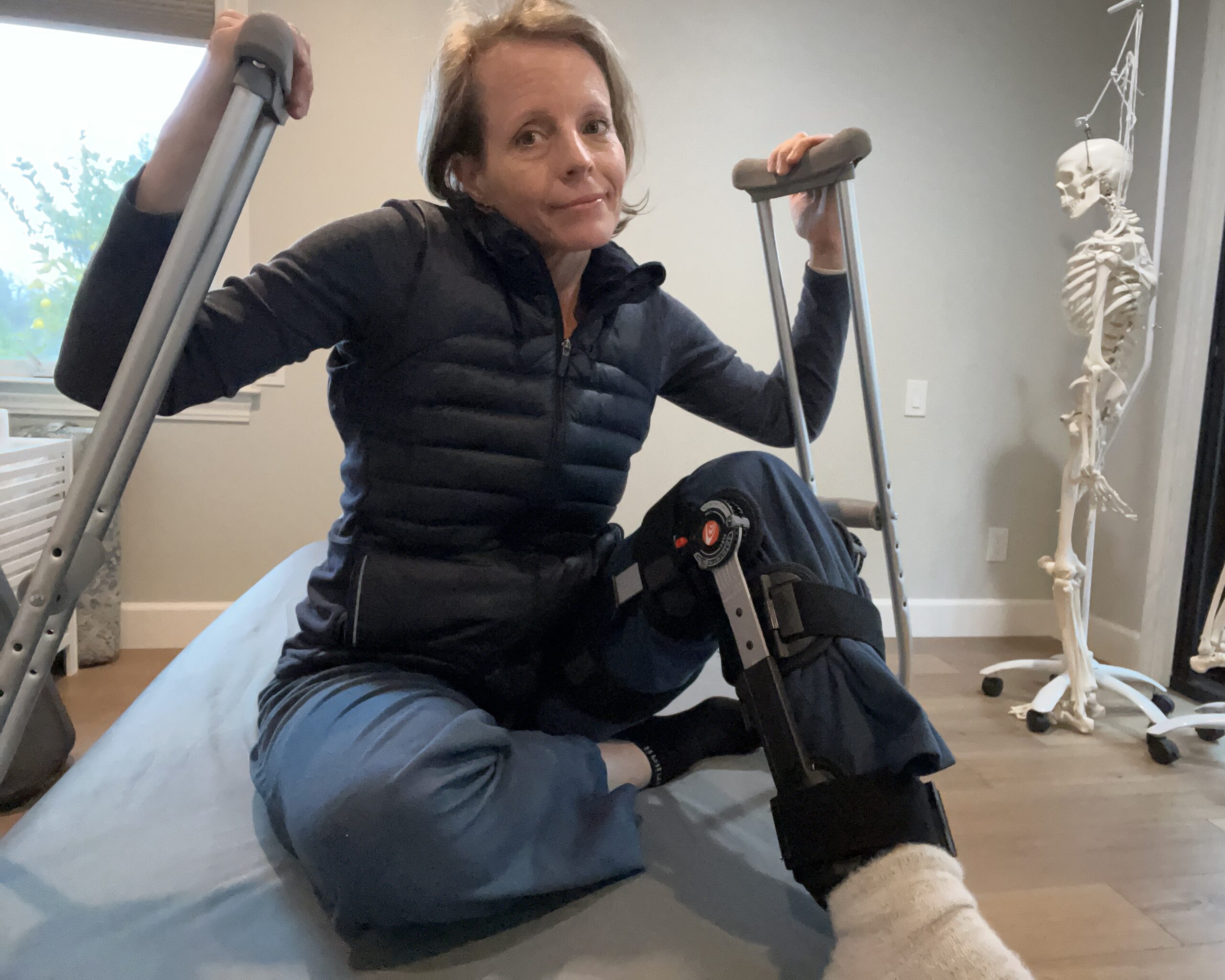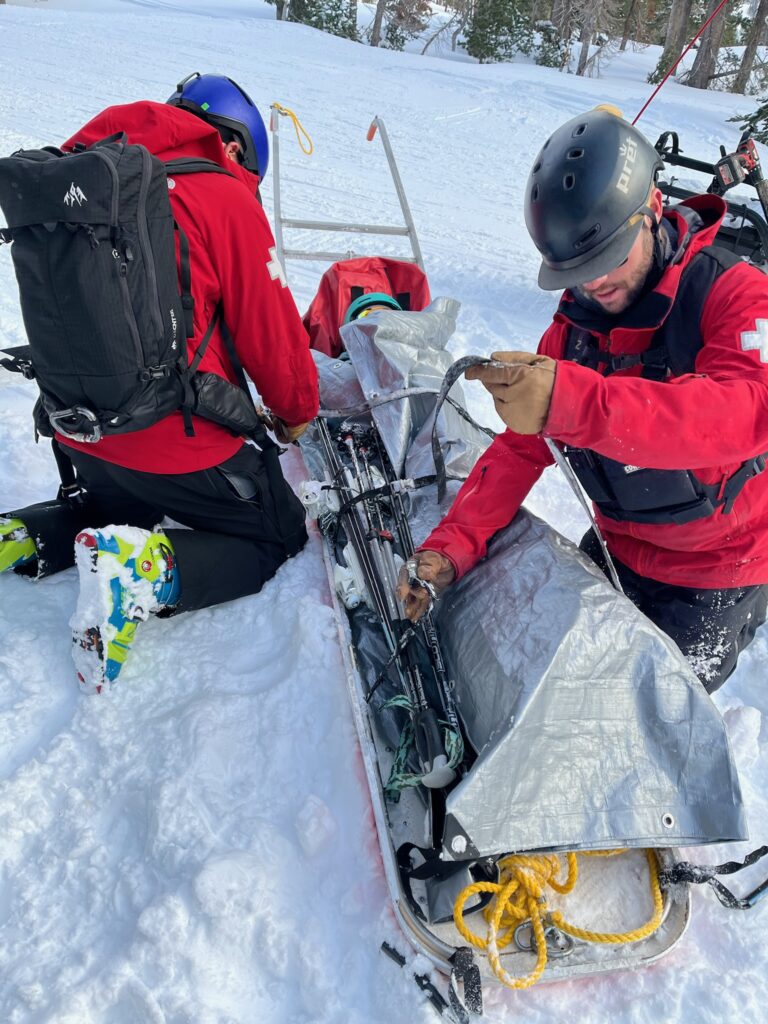Breaking Away from the Path Well Traveled

This is a follow-up to my post from Jan 16.
Why, you might ask, am I in a surgical brace now, despite being able to walk just fine 2 weeks ago?
A lot has happened (especially in my head) over the last couple of weeks, but first, let me step back a bit to the day of my last post.
The orthopedic knee surgeon basically told me that if I really wanted to ski again, then there’s no doubt I’ll need surgery to reconstruct my ACL. But first we need to see how I’m doing after a few months of walking and trying to regain normal gait as we wait for my MCL sprain to heal (which the medial collateral ligament is known to do when it’s only a grade 2 sprain).
Step 1: heal the MCL (3 month plan)
Step 2: see if instability is limiting my activities of daily living, in which case we prep for surgery.
oh, you want to ski again? Well then…
Step 3: After knee is “quiet”, definitely get surgical reconstruction of the ACL
Dr: “Do you have any other questions?”
Me: “Yah, when and in what way do we start to work PT into my recovery plan?”
Dr: “No need. In your situation, we normally don’t refer to PT”.
Me: (to myself) WTF?!?
Some might call it denial, but something really wasn’t feeling right to me. I was going to have to do more research on my own. Since then, here’s what I’ve learned (with corresponding references).
- Women are 2-4x more likely than men to tear their ACL, but there’s really no consensus on why.
- MRI reports of full ACL tears aren’t necessarily as accurate you might think.
- MRI’s are considered to have a very high diagnostic accuracy, but that’s based on the use of thin-slice T2-weighted and oblique sequences. Without this, the false positive rate for full-tears, especially when swelling is still present, can be pretty high.
- A new modified MR dual precision positioning of thin-slice oblique sagittal fat suppression proton density weighted imaging — “The misdiagnosis rate of anterior cruciate ligament (ACL) tear of the knee joint is as high as 47% due to the confusion of high signal generated by synovial hyperplasia and partial volume effect on the standard MRI sequences”
- Contrary to what many orthopedic surgeons are still saying (in clinic and on YouTube) and what they and PTs might still be learning in school, the ACL is in fact capable of spontaneous healing,
- Healing potential of the anterior cruciate ligament in terms of fiber continuity after a complete rupture: A systematic review (2021) — demonstrates the intrinsic healing capacity of the anterior cruciate ligament, indicating a higher healing potential for proximal ruptures.
Spontaneous healing of the anterior cruciate ligament (ACL) remains controversial to date. Poor healing potential has previously been described in animals (Hefti et al., 1991; O’Donoghue et al.,1966), whereas several studies have reported healing of a completely ruptured ACL after conservative management. - Intrinsic Healing Response of the Human Anterior Cruciate Ligament: An Histological Study of Reattached ACL Remnants (2013)
study shows that the human proximal 1/3 ACL has an intrinsic healing response with typical histological characteristics similar to the MCL.
- Healing potential of the anterior cruciate ligament in terms of fiber continuity after a complete rupture: A systematic review (2021) — demonstrates the intrinsic healing capacity of the anterior cruciate ligament, indicating a higher healing potential for proximal ruptures.
- Despite being an arthroscopic procedure with small incisions, ACL reconstruction surgery is actually a pretty invasive procedure, with less-than comforting outcomes and complications.
- First, they harvest a graft from one of your own tendons (patellar, hamstring, or quadriceps), leaving that muscle/tendon weakened (see Graft choices for ACL recontruction)
- Then they remove your original ACL ligament, and drill tunnels through the bottom of the femur and the top of the tibia to feed the graft through. The drill hole position is important, as is the technique they use (such as double-bundle to better approximate the natural mechanics of the original multi-bundle ligament). See example of one technique published here.
- In some cases, post-surgical instability is present even after successful surgery and rehabilitation. Doctors and researchers are still finding the answers to why this may occur (VerywellHealth.com),
- The total rate of complications after an ACL reconstruction was 39%, and the surgical revision rate for any reason was 28% (Sage Journals)
- Athletes offered rehabilitation instead of early surgery showed ACL healing on MRI and better patient-reported outcomes.
- A Randomized Trial of Treatment for Acute Anterior Cruciate Ligament Tears (New England Journal of Medicine, 2010) — Knee Anteriro Cruciate Ligament Nonsurgical versus Surgical Treatman [KANON] study in Lund, Sweden
surgical reconstruction was avoided in 61% of the subjects without compromising the results … no significant differences in self-reported outcomes at 2 years among the subjects treated with rehabilitation plus early ACL reconstruction, those treated with rehabilitation plus delayed ACL reconstruction, and those treated with rehabilitation alone - Evidence of ACL healing on MRI following ACL rupture treated with rehabilitation alone may be associated with better patient-reported outcomes: a secondary analysis from the KANON trial.
Almost one in three participants offered supervised exercise therapy with an optional delayed anterior cruciate ligament (ACL) reconstruction had MRI evidence of spontaneous ACL healing two years after an ACL rupture. Those who healed are more likely to report better patient-reported outcomes than participants without healing or who received an early or delayed ACL reconstruction.
- A Randomized Trial of Treatment for Acute Anterior Cruciate Ligament Tears (New England Journal of Medicine, 2010) — Knee Anteriro Cruciate Ligament Nonsurgical versus Surgical Treatman [KANON] study in Lund, Sweden
- Dr. Tom Cross (sports medicine physician at the Stadium Clinic, Sydney, Australia) had a theory that if the knee is kept at 90 degrees during the critical healing period, the ACL will have a better chance of healing itself. Together with PT Stephanie Filbay, they seem to be proving this.
- Healing of acute anterior cruciate ligament rupture on MRI and outcomes following non-surgical management with the Cross Bracing Protocol (BMJ 2023)
MRI studies showed that 90 % of participants had evidence of ACL healing at 12 weeks - See bio about Dr. Tom Cross including his CV and publications.
- Everything there is to know about the Cross Bracing Protocol (for patients and practitioners): healacl.com
- Cross Bracing Protocol for Native Healing of the Anterior Cruciate Ligament (Muskuloskelettale Physiotherapie 2024)
A formal randomized clinical trial comparing ACL reconstruction to the Cross Bracing Protocol due to start early 2025 - The news is starting to make it to the US, but none of the doctors I spoke to (1 ortho, and 1 sports medicine) had heard of it.
- Wall Street Journal: A torn ACL can heal itself, new study shows. Surgeons disagree. (WSJ 2023) [news article]
Almost all knee experts considered torn ACLs irreparable, with surgical reconstruction usually required to keep the knee functional. But the new research, which focused on 80 injured knees, found that many torn ACLs can apparently knit themselves back together and heal naturally — reducing the need for expensive and often painful surgery. - NBC News: Torn ACLs may heal with therapy instead of surgery, though some surgeons aren’t convinced
- Wall Street Journal: A torn ACL can heal itself, new study shows. Surgeons disagree. (WSJ 2023) [news article]
- Healing of acute anterior cruciate ligament rupture on MRI and outcomes following non-surgical management with the Cross Bracing Protocol (BMJ 2023)
So, needless to say, my biomedical-engineering-clinical-research mind combined with my fundamental belief in the body’s propensity for self healing (when given the right conditions) have driven me to run my own single-subject case study.
After finding a sports medicine doctor who is OK with my bracing and PT strategy, and a physical therapist who’s curious, adaptable, and open to supporting me through the rehabilitation (and not booked out 4+ weeks), I begin PT in 2 weeks 😁.
Meanwhile, I continue my self-guided awareness through movement (ATM) explorations, with a special focus on using the mobile leg to help guide my imagination of moving the immobilized leg. I know through the many ATM lessons I’ve done over the years that imagining movements can be even more powerful than doing them, so I’m eager to see what effect all this imagining has had on its function when I finally remove the brace. At a minimum, I am confident it will have reduced the degree of dis-function compared to what would likely have happened if I let my motor cortex remain immobilized too.
I’m also trying to keep my strength up with exercises such as crutch-assisted chair pose (Utkatasana), kneeling pushups and planks (kneeling on a soft bolster), and “Donkey Kicks” (see quadruped bent-knee hip extension).
Stay tuned for updates on my progress. Wish me luck!
p.s. Yes, getting around with one leg at 90 degrees for a few weeks is a royal pain in the butt. But from what I hear, recovery from ACL surgery isn’t a walk in the park either.


